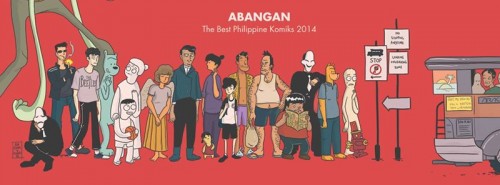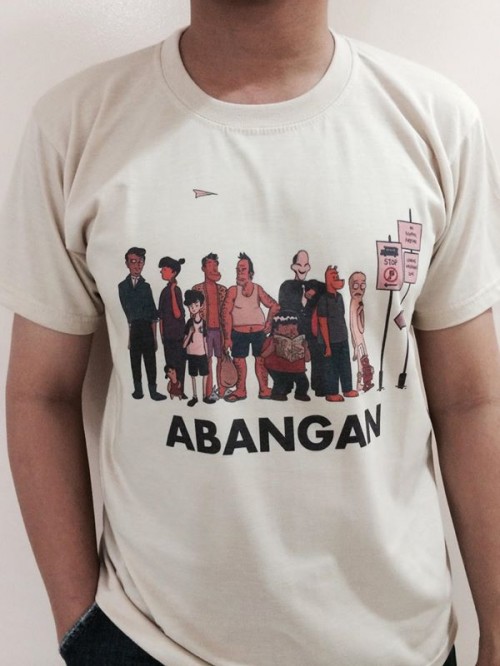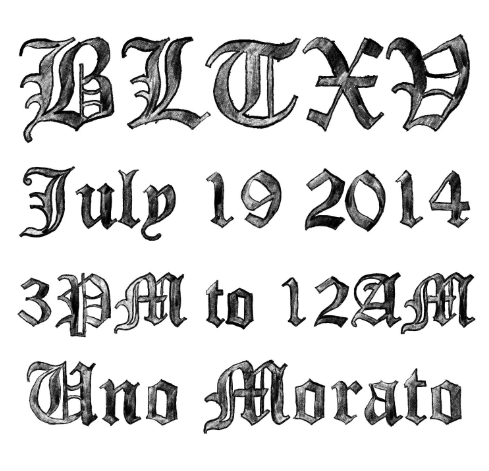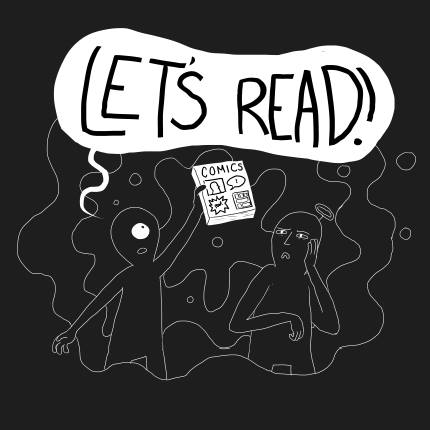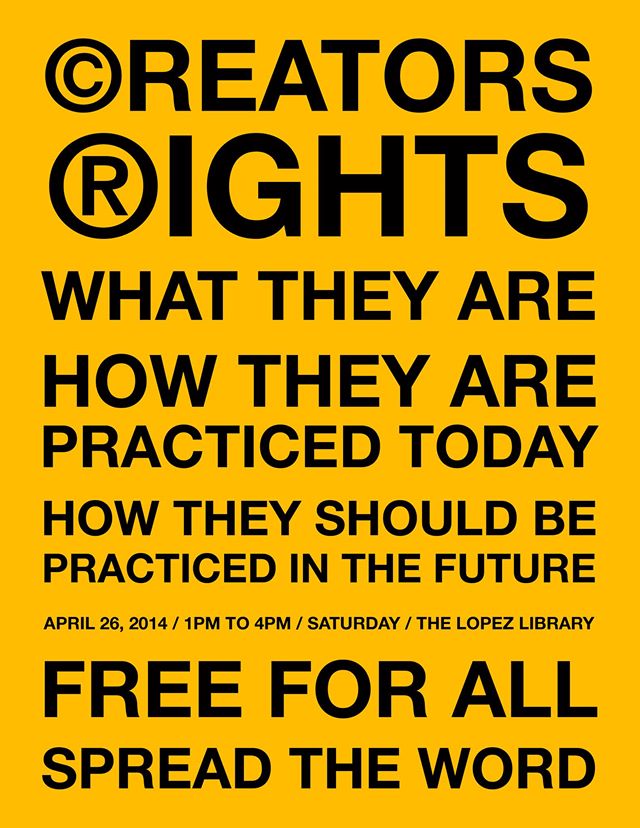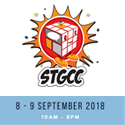ABANGAN! Adam David about Komiks atbp
FLIPGEEKS: Hi Adam. Tell me about Abangan.
ADAM DAVID: Hmmm. Here goes, and keep in mind that this is my own interpretation of what ABANGAN is and what it could be: ABANGAN is a multi-pronged effort at spitting and polishing off some of the accumulated grime from the komix field, generally speaking. The multiple prongs are mainly PR-/image-centric, in the sense that we wanted to feature the stories and artists and writers we felt either needed a firmer push forward from out of the crowd, as well as the stories, artists, and writers we feel represent the better more mainstream production.
The idea for ABANGAN was borne of co-editor Carljoe Javier positing the question of making an anthology whose primary purpose is to attract foreign readers, make them pay attention to contemporary Filipino komix production, that we – as a nation of artists and writers – are not just Whilce Portacio, Leinil Yu, Roy Allan Martinez, Gerry Alanguilan, Lan Medina, that we are doing a range of stories of differing styles and dispositions, some of which may be appealing to people outside of the country.
Of course, there is also a focus on the local audience, especially the people who only know about komiks from Carlo J. Caparas or FUNNY (Komiks) and ST and the dozens of sci-fi and horror komiks sold in bangketas for so long during the 80s. We wanted to show them that time has passed, and with it some progress with regards to the aesthetic and narrative concerns of the art. We made efforts to show that as much as the current production is dictated by the Western comics market paradigm – macho superhero manga adventures – there is also production that is not that (which is the most egalitarian term one can use to describe all the others), and that they are also both aesthetically-pleasing and marketable: Manix Abrera is probably the most famous of these non-superhero non-manga non-macho komix peeps, and Mica Agregado is probably the most obscure. Both of them are in ABANGAN, and are actually the bookends for the antho. And in between we have macho superheroes, manga fantasies, slice-of-life confessionals, essays, deconstructionist commentaries on the komix form.
FG: What do you think of what the foreign audience view on Filipino komiks?
AD: I wouldn’t know, [laughs]. But if forced to imagine, I’d bet it’d be exactly like my reaction when I read komix from Croatia, Norway, Sweden: fascination for a nation with an artistic growth pattern that is both unfamiliar and strange. The best thing about unfamiliar and strange things is that you as a reader tend to not know how such things will develop, in the case of stories, you’ll probably not know how these stories will pan out, how these stories will end. That means it’ll be a new experience for these readers, which is probably the best thing any book (or movie, or TV show, or anything) can offer a reader, especially in a globalised market still primarily dictated by the West. They give readers new types of stories to think about and enjoy, new forms to problematise and maybe even mimic and develop on their own as their own things. With something like Dark Chapel’s work, for example. Imagine someone who had been reading, say, PENNY ARCADE and HARK! A VAGRANT, and whose only experience with Pinoy komix is Michael DeForge’s “Manananggal” or Lynda Barry’s “Aswang,” how would that reader react to Dark Chapel’s komix essay on the history of the videoke. First reaction would probably be, “They have videokes in the Philippines? I thought that was Japanese and/or Korean-Chinese!” Next reaction will then probably be, “This is how manga is like in the Philippines? It’s weird!” Then the next reaction will probably be, “What a strange thing, a manga essay on videoke. They do that in the Philippines. Who would’ve thunk??!?!!?!?” Love it or hate it, these three things will most likely be in those people’s minds when they read Dark Chapel’s piece in the antho. Well, if they get to understand the language first, as it’s writtenin Filipino! Regardless, though, I bet my puwet that’ll happen to Molina and Sta Maria’s SIXTY-SIX, to Nones and Cham’s COMICS, to Nicolas’ WINDMILLS, etc etc.
Check out our ONE-FOURTH INDIE REPORT: Chapel’s Huling Hirit?
FG: Do you think that our lokal comic creators have been so focused targeting the local audience that they haven’t thought about the potential market outside country?
AD: I think it’s best to concentrate on producing, maintaining, and developing a local audience. I believe in the local audience far far more than I do the foreign audience. But with the economic and trade developments about to happen with the ASEAN nations in the coming two years – in short, the Philippines is about to announce the country as open market for Malaysia, Singapore, Vietnam, et al, on the very fundamental level of (in terms of us as komiks artists and writers) various foreign publishers now being able to look at our pool of creatives and say “We want to publish your book for the global market” – we need to prepare ourselves significantly image-wise and archive-wise in the sense that we need to start digging through our local production of the last ten, thirty years of komix/komiks and start thinking what really among all these pages or art and letters is worthy of saying that they are good enough to be seen in the global market as our representatives. Deciding exactly which are deserving is a whole ‘nother table of steaming bullshit, of course! So, it’s all going to be about curatorship in the coming two years, I think.
FG: Do you think all komiks should mostly now be made/transcribed in English then?
AD: Most Filipinos are mainly bilingual to begin with – working knowledge of Filipino (whichever Filipino language that is: Tagalog, Bikol, Cebuano, Ilonggo, etc) and at the very least a comprehension of English – and with komix artists and writers being more educated than some (to make komix you first need to have read comic books, so that means you know how to read [and typically, what komix peeps read are English-language comic books], and to make komix, you also need to know how to draw and how to write, and these things need certain economic accomplishments to have under your belt [translation: lahat ng komikero ay edukado]), so I don’t think it’ll be a struggle to choose if you want to do your komix in one language or in two. As someone who mainly writes in English yet educated in Filipino-language writing (my college dropout degree was Malikhaing Pagsulat – Creative Writing in Filipino) and has been writing for more than ten years (and not just komix), the question of which language to write on is mainly a book-by-book basis – the project demands the way it needs to be written. Language concerns, as discussed above is mainly about selling the book. I think that’s something that’s best addressed after you address the more pressing concern of making the book first. So, in terms of ABANGAN, we did translations for some and we did original language for most. Which means, some of the Filipino-language stories are still in Filipino, some were translated for this antho. Some stories you just really need to read in the language of their conception. Like Dark Chapel’s!
FG: With ABANGAN soon to be released this April, ano ang in-eexpect mo na turn out from the people who will read the book?
AD: I have a short answer for that one, fortunately: personally speaking – in short, not speaking for Elbert, Rob, and Carl – my intentions for the antho is to cross-pollinate the various and divergent aesthetics of contemporary komix production in terms of primarily the artists themselves in the antho realising the existence of each other’s production and maybe in some way influence one another. The other cross-pollination is with regards to the readers, how the fans of Budj’s and KaJo’s TRESE will then get to read JP Palabon’s PUSO NEGRO, or how the fans of Emiliana Kampilan’s DEAD BALAGTAS will then get to read Paolo Fabregas’s FILIPINO HEROES LEAGUE and maybe see some sort of nationalist kinship between the two and decide to give that book a try, too.
Check out our recent: ONE-FOURTH REPORT: JP Palabon Showing his Golden Balls this Summer 2014
FG: Most of the stories inside are reprints/excerpts, yes? in the introduction you and the rest of the editors mentioned that these stories/creators are the best that came out within the past year. which ones did you root for? For next year’s format, will it be again a series of excerpt/reprints?
AD: Actually, all of the stories are excerpts or reprints of some sort – some not yet out, some published online, some published in print, some published in broadsheets. Our initial blueprint was the BEST AMERICAN COMICS antho series edited by Matt Madden and Jessica Abel, and its virtue of being an annual meant it was a book of excerpts and stuff previously published elsewhere. So far in our plans for the coming volumes, we’re sticking by that formula, although I’m hoping we deviate from it every once in a while. That said, we really made a point to cast a really wide net and to have our standards be as inclusive as possible (without sacrificing our critical eyes and noses, of course). As someone who had co-edited (and solely-edited) a number of anthos already, the discussions amongst ourselves with regards to the selection process was very very sedate, and we found ourselves agreeing with most if not all of the works included. The bulk of the work was really more on what works we had to pull out from the antho due to pagecount issues. We talked about everything every step of the way, though, so we were always on the same page. For my own picks, though, I can’t really remember which stories I picked out specifically, although I took care of the initial handling for Mica Agregado’s “Blue Dusk,” hounded Molina and Sta Maria for SIXTY-SIX, and mentioned that the TRESE story in Haggedorn’s MANILA NOIR was a stronger story than the TRESE BOOK 6 excerpt that they initially gave us.
FG: How did you recruit the contributors? Was there bacon involved? [laughs]
AD: After we decided on a number of stories and creators we liked – about a dozen or so, if I remember correctly – it was decided that Carl and I would share the bulk of the contacting of people and gathering the works. Carl and I divided evenly the responsibility to contact the people we wanted to be involved in the project, while Elbert and Rob took care of the design aspect of the book. We had individual tasks assigned to ourselves, which we all did mostly well (I flaked out on some of my own, unfortunately). As demonstration of how we divided and integrated the work: Carl wrote the bulk of the intro, and I added and embellished a number of things in it, hopefully quite successfully seamlessly; Rob drew the initial layout, design, and embellishments for the cover, while Elbert embellished some more and actually finished/finalised the overall cover art and design (it’s a testament to Elbert’s abilities that people actually mistake the cover art to be Rob’s work alone). All four of us decided on the flow of the works, the reading experience, what had to be in the intro, what had to be in the cover, how we’ll promote it, how we’ll market it … we talk about everything about the book. It’s really a collaboration through and through.
On the food front, what was involved were sandwiches, fruit shakes, and coffee.
FG: How many candidates were there initially? What were the faults of the candidates who did not pass?
AD: Can’t remember exactly how many creators and stories were mentioned, but some of them dropped out because they just didn’t feel like sending their work, their rationale being they don’t have anything new to give us, “new” being “work published in 2013,” but also “new” being we gave them the option to give us unpublished work if they felt that was a better sampling of their production. Some were cut out because having them in the antho would cause some sort of imbalance to our attempt at widening the genres in the antho or a pause to the inertia we were trying to establish on the reading order. Our responsibility was really to the book, for the book to be as inclusive and as coherent as possible. I don’t think it’s perfect, but it’s probably one of the more measured and more educated anthos out there, in terms of curatorship.
FG: What kind of stories that would not fit for ABANGAN?
AD: I don’t think there are stories that won’t fit the antho. We had no urge to censor ourselves in any moral way, and our standards for tolerance for art style is really not very high in the sense that we don’t judge art as being too cartoony or not anatomically correct or not educated on perspectives or not Pinoy enough or too Pinoy or whatever. The initial standard, and the standard that we applied to the whole project as we were going through it, was what we thought and felt were good komix, were komix that proposed a lot of new things, new ways of seeing and thinking, komix that are not comfortable with just being mere art and letters printed on a piece of paper. Which is to say, if we actually found a komix that was, say, an adaptation of the Book of Leviticus, and also a komix that was about the rape and subsequent suicide of 80’s bold star Pepsi Paloma, if both were really good works based on the standards of us four editors, we wouldn’t have any hesitation including both works in the same book.
FG: For you, sino yung driver ng jeepney sa ABANGAN album art?
AD: The jeepney driver, I wouldn’t know. [laughs] I’d like to think it was one of the (Kubori) Kikiams, with one Kikiam as the driver’s assistant, while the third Kikiam as the barker.
FG: Thoughts on the Eric Stephenson speech?
AD: Ah, I liked his speech, and I agree with it wholeheartedly. I wish we had someone like him in a prominent position in our own komix industry. The problem with most komix peeps is they always focus on the bottomline, which is how to sell out – it’s always about the IP, always about how to exploit it in other media, etc etc, and no real problematising how such a mindset may affect contemporary and future production. Everyone’s chasing the next DARNA or the next PANDAY. Nobody’s really thinking about how to strengthen the market first for everyone concerned, how to establish a more ethical practice of dealing with publishers, how to show people that komix are not just about guys fantasizing about a Pinoy JLA-AVENGERS-TEEN TITANS-X-MEN.
Well, Gerry Alanguilan used to do it quite frequently, but you have to kinda dig through his blog archive to get to those essays. We need to be constantly reminded about these things, we need to constantly think about these things. When we don’t talk about them regularly, we tend to forget that we need to talk about them. We need to talk about them as frequently as we talk about what we prefer, ARROW or SHIELD.
FG: The usual komiks stories adapted sa TV nowadays are fantasies, do you think all general people would define komiks as that these days?
AD: Oh yes, I’m very sure that’s how most people here perceive komix. Pretty much the same way that you don’t really think of ROAD TO PERDITION or BLUE IS THE WARMEST COLOR or A HISTORY OF VIOLENCE when you think of comic book movies. And it’ll always be that way, I think. The only real possible solution here is to produce work that are not like the Caparas and Caparas-derived TV shows (like JUAN DELA CRUZ), and hope that once we get these people into the cons and stores looking for superhero and fantasy stuff, they’ll find all the weird and personal and kiddie stuff, too, and hopefully there’ll be enough of those that the impression that’ll last in that person’s head is that komix aren’t just superheroes and fantasy stuff.
FG: What komiks stories could you suggest that can be adapted sa tube that is outside the superhero and fantasy genre?
AD: I wouldn’t mind an ANG TV revival with nothing but stints from Dark Chapel’s SILENT SANCTUM MANGA books. A TGIS/LUV U show based on Nicolas’s WINDMILLS. Elbert’s HOMEYCOMB strips would make good JOHN EN MARSHA bits. Manix’s KIKOMACHINE would make a good sitcom a la PARKS & RECREATION, but only with college students being followed by a Film undergrad doing his thesis.
FG: I always thought that a dark reality show about a call center agent would work something dark and depressing rather than romance and torpe scripts. [laughs]
AD: Puwede, di ba?
FG: No more of that classic Romeo and Juliet situations and the mayaman falls to mahirap (in both ways). But it would be nice to see those mid-film dance/song numbers. [laughs] Puso Negro would be a good TV show.
AD: TOTOO.
At maganda nga ang kaunting kakengkoyan na ganyan musicals bigla sa gitna for no good reason [laughs]
FG: Sa early conversations natin na before ang intirview na ito, sabi mo that editors would change every volume/contributors as well?
AD: Ay, no, I said I hope the editors would change every volume, [laughs]. But definitely the contributors will. It’s all going to be primarily based on the previous year’s komix production. So, if for some reason Manix Abrera won’t be releasing anything this year, he won’t be one of the selections for next year.
FG: What if a contributor of for next year wont release anything but would like to contribute something new, pwede ba un?
AD: Hmmm. I’d allow it, but I think (and this is just me speaking, of course) I wouldn’t put them in the priority list, seeing as they were already part of the prior antho. My inclination is to always put in different/new creators and stories in the antho.
FG: Do you already have candidates for next year? Can anyboday contribute fo next year?
AD: No candidates, yet, but for sure we’ll find a few this coming komikon. And definitely everyone’s invited to send us their works! Or send us links to people’s work we may otherwise overlook. We can’t be expected to read everything, but the project demands that we do, but even on a practical level, and most definitely on an economic level, we can’t be on top of all the komix production for any given year, so we’ll appreciate any help we can get on that regard.
of course ABANGAN ang title ng book, when you finally decided for the final list of contributors, may sense na parang may inaabangan or expectations ka or kayo ng mga editors sa kanila (as a group and as an individual) ABANGAN
Ah yes, it was decided for that reason, most definitely: komix work you have to look out for, creators you have to watch out. It’s also referencing the nature of most stories in the antho being excerpts, that they continue elsewhere outside of the book. It is also an emblem, a promise about the future of komix, how we perceive it to be.
FG: So far, with the new komiks coming out, who do you think is ABANGAN material? Who do you think people should look out for this 2014? How are you guys promoting this?
AD: Potential candidates for next year’s antho, I don’t really know yet. I’m really hoping for more women, and definitely work from outside of Manila. We’re gonna actively look for that sort of work. We want to be really as wide as possible, as varied as possible, while still maintaining the simplest definition of “best” with regards to komix work produced for the given time period.
Ewan ko sa gimik pa for promoting it! May ginagawa naman na, like the discounts, the pre-ordering, the tshirts
Also, there’s going to be a song for the antho
FG: Ikaw nagcompose?[laughs]
AD: Ay, hindi.
Totoong musikero ang gumagawa! [laughs]
FG: Why should people get ABANGAN?
AD: People should get ABANGAN if they plan to follow new and divergent conversations about the development of contemporary Pinoy komix. Things need to change, things are about to change. The editors and I would like to think that this antho is pointing towards a particular direction that komix need to explore if it has any plans on growing up.


